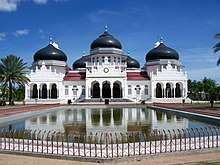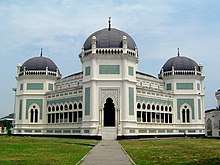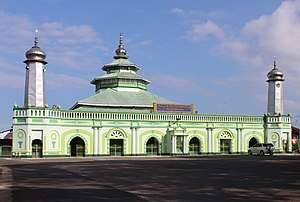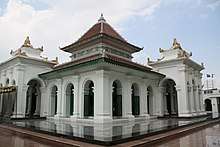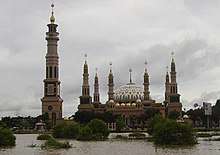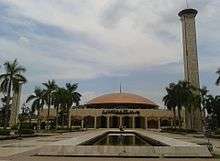Istiqlal Mosque, Jakarta
Istiqlal Mosque (Indonesian: Masjid Istiqlal, lit. 'Independence Mosque') in Jakarta, Indonesia is the largest mosque in Southeast Asia and the third largest Sunni mosque in term of capacity.[3] This national mosque of Indonesia was built to commemorate Indonesian independence and named "Istiqlal", an Arabic word for "independence". The mosque was opened to the public 22 February 1978. Within Jakarta, the mosque is positioned next to Merdeka Square and the Jakarta Cathedral.
| Istiqlal Mosque | |
|---|---|
Masjid Istiqlal | |
Istiqlal Mosque, largest mosque in Indonesia and South East Asia | |
| Religion | |
| Affiliation | Islam |
| Branch/tradition | Universal Sunni |
| Leadership | |
| Location | |
| Location | Jakarta, Indonesia |
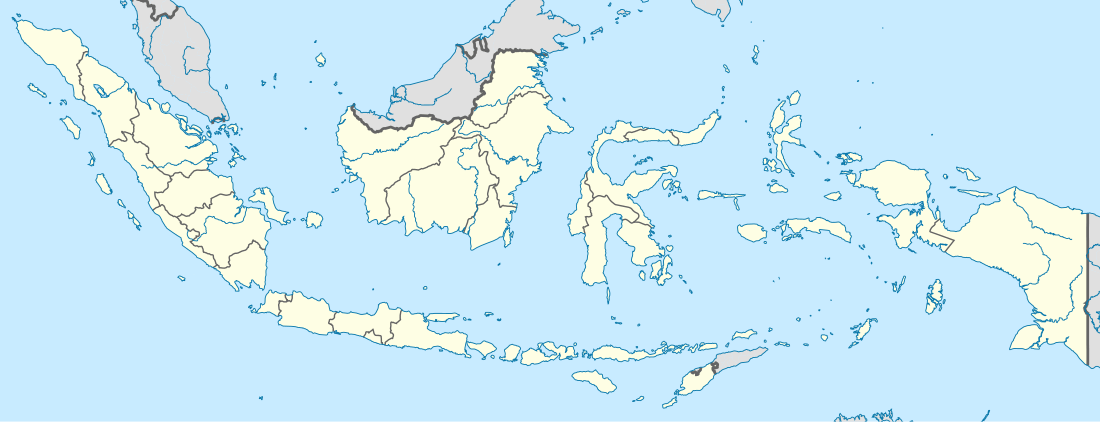 Location in Indonesia | |
| Administration | Ministry of State Secretariat with Ministry of Religious Affairs of the Republic of Indonesia |
| Geographic coordinates | 6°10′11″S 106°49′51″E |
| Architecture | |
| Architect(s) | Frederich Silaban |
| Type | Mosque |
| Style | New Formalism (architecture) |
| General contractor | Republic of Indonesia |
| Date established | 1978 (renovated in 2019-2020)[2] |
| Construction cost | Rp 7 billion (US$ 12 million) |
| Specifications | |
| Capacity | 200,000 people |
| Dome(s) | 2 |
| Dome dia. (outer) | 45 m (148 ft) |
| Minaret(s) | 1 |
| Minaret height | 96.66 metres or 317.1 feet high; 66.66 m or 218.7 ft marble coated structure; plus 30 m or 98 ft stainless steel pinnacle |
| Materials | steel and concrete structure, marble tiles on floors, walls and domes, ceramics tiles, stainless steel ornaments and metalworks |
| Website | |
| istiqlal.id | |
History
Before the mosque
%2C_Bestanddeelnr_127-6-6.jpg)
The mosque was formerly the location of the Wilhelminapark and a 19th-century Citadel.
Design and competition
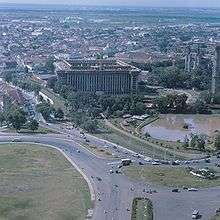
After the Indonesian National Revolution 1945–1949, followed by the recognition of Indonesian independence from The Netherlands in 1949, there was a growing idea to build a national mosque for the new republic, which had the largest Muslim population in the world.[4] The idea of constructing a grand Indonesian national mosque was launched by Wahid Hasyim, Indonesia's first minister for religions affairs,[5] and Anwar Cokroaminoto, later appointed as the chairman of the Masjid Istiqlal Foundation. The committee for the construction of the Istiqlal Mosque, led by Cokroaminoto, was founded in 1953. He proposed the idea of a national mosque to Indonesian President Sukarno, who welcomed the idea and later helped to supervise the mosque's construction. In 1954 the committee appointed Sukarno technical chief supervisor.[6]:106
Several locations were proposed; Mohammad Hatta, Indonesian vice president, suggested that the mosque should be built near residential areas on Thamrin avenue, on a plot where Hotel Indonesia stands today.[7] However, Sukarno insisted that a national mosque should be located near the most important square of the nation, near the Merdeka Palace. This is in accordance with the Javanese tradition that the kraton (king's palace) and masjid agung (grand mosque) should be located around the alun-alun (main Javanese city square), which means it must be near Merdeka Square.[8] Sukarno also insisted that the national mosque should be built near Jakarta Cathedral and Immanuel Church, to symbolize religious harmony and tolerance as promoted in Pancasila (the Indonesian national philosophy and the five principles which constitute the philosophical foundation of Indonesian nationhood).[9] It was later decided that the national mosque was going to be built in Taman Widjaja Kusuma (formerly Wilhelmina park), in front of the Jakarta Cathedral. To make way for the mosque, the Citadel Prins Frederick, built in 1837, was demolished.[10][11]
Sukarno actively followed the planning and construction of the mosque, including acting as the chairman of the jury for the mosque design competition held in 1955. The design submitted by Frederich Silaban, a Christian architect from North Sumatra, with the theme "Ketuhanan" (English: "Divinity") was chosen as the winner.
Construction
The foundation stone was laid by Sukarno on 24 August 1961;[12][13] the construction took 17 years. President Suharto inaugurated it as the national mosque on 22 February 1978.[12][14] As of 2013 it is the largest mosque in the region of Southeast Asia, with a capacity of over 120,000.[15][16]:65
Contemporary events
On Friday night, 14 April 1978 a plastic bomb exploded near the mimbar in Istiqlal Mosque, no casualties in this explosion.[17] More than 20 years later, on 19 April 1999 a second bomb attack exploded in basement of the mosque, breaking the glass of the office rooms.[18]
Between May 2019 to July 2020 the mosque undergone major renovation. Among other by polishing and cleaning the marble exterior and stainless steel geometric ornamentation, new mihrab and mimbar, upgrading electrical and plumbing systems, new lighting system using LED lamps, renovation of VIP rooms, new gates and improvements of garden, park and plaza, new kiosk for vendors, and also two storied basement parking space.[19] The mosque is planned to reopen in July 2020. [2]
A tunnel connecting Istiqlal Mosque and St. Mary of the Assumption Cathedral is being constructed by Indonesian authorities. This tunnel, known as the "Terowongan Silaturahmi" (Tunnel of Friendship), is expected to finish in April 2020 before Ramadan 2020.[20]

Structure
The mosque has seven entrances, and all seven gates are named after Al-Asmaul-Husna, the names of God in Islam.[21] The number seven represents the Seven Heavens in Islamic cosmology.[22] The wudu (ablution) fountains are on the ground floor, while the main prayer hall and main courtyard are on the first floor. The building consists of two connected rectangular structures: the main structure and the smaller secondary structure. The smaller one serves as main gate as well as stairs and prayer spaces.
Entrance gates
There are seven entrance gates to the Istiqlal Mosque. Each door is named after one of the 99 Names of Allah. Below are lists of entrance gates into the complex of Istiqlal Mosque:
- Main gates
- Al Fattah/الفتاح ("The Opener"): Located opposite of the Jakarta Cathedral. This is the main entrance for visitors, which also leads to the main parking area.
- Ar Rozzaq/ٱلْرَّزَّاقُ ("The Provider"): Located at Jalan Perwira. The door leads to the main parking area.
- As Salam/ٱلْسَّلَامُ ("The Peace"): Entrance for important guests e.g. clerics or ambassadors. The entrance leads to the front rows near the imam.
- Other gates
- Al Quddus/ٱلْقُدُّوسُ ("The Holy"): Located on the northeast of the mosque complex.
- Al Malik/الملك ("The King"): Located on the west of the mosque complex. Used for very important guests e.g. the president of Indonesia or other important guests.
- Al Ghaffar/ٱلْغَفَّارُ ("The Forgiving"): Located on the south end of the courtyard hall building, just below the minaret of Istiqlal Mosque. This door is the closest to the southeast gate as well as the furthest from the mosque mihrab.
- Ar Rahman/ٱلْرَّحْمَان ("The Compassion"): Located on the southwest corner of the mosque's hall building, near the entrance gate of Al Malik.
Dome

The rectangular main prayer hall building is covered by a 45-m diameter central spherical dome; the number "45" symbolizes the 1945 Proclamation of Indonesian Independence.[12][23] The main dome is adorned with a stainless steel ornamental pinnacle in the form of a crescent and star, the symbol of Islam. The smaller secondary dome is also adorned with a stainless steel pinnacle with the name of Allah (God) in Islamic calligraphy.
The dome is supported by twelve round columns, and the prayer hall is surrounded by rectangular piers carrying four levels of balconies. Twelve columns represent the (mostly accepted) birthday of the Islamic prophet Muhammad in 12th Rabi' al-awwal.[24]
Interior
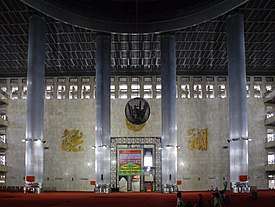
The main floor and the four levels of balconies make five floors in all; the number "5" represents the Five Pillars of Islam and also Pancasila, [25] Staircases at the corners of the building give access to all floors. The main hall is reached through an entrance covered by a dome 8 meters in diameter; the number 8 symbolizes August, the month of Indonesian Independence. The interior design is minimalist, simple and clean-cut, with a minimum of stainless steel geometric ornaments. The 12 columns are covered with stainless steel. On the main wall on qibla there is a mihrab and minbar in the center. On the main wall, there is a large metalwork in Arabic calligraphy, spelling the name of Allah on the right side and Muhammad on the left side, and also calligraphy of Surah Thaha 14th verse in the center. The metalworks, stainless steel covers and ornaments were imported from Germany. Originally, as in the National Monument nearby, the white marbles were planned to be imported from Italy. However to cut costs and support the local marble industry, it was later decided that the marbles would be from Tulungagung marble quarries in East Java instead.[26]
Minaret
The main structure is directly connected to the arcades that are spread around the large courtyard. The arcades connect the main building with a single minaret in the southern corner. Unlike many Arabic, Persian, Turkish and Indian mosques with multiple minarets, Istiqlal mosque has a single minaret to symbolize the divine oneness of God. It is 66.66 m tall to symbolize (incorrectly[27]) the 6,666 verses in the Quran.[28] The 30-metre-high stainless steel pinnacle on top of the minaret symbolizes the 30 juz' of the Quran.[29] On the southern side near the minaret there is also a large bedug (large wooden drum made of cow skin).[30] In common with the entire Islamic world, traditionally Muslims in Indonesia use the drum with the adhan (call to prayer). The mosque offices, function hall, and madrasah are on the ground floor. The mosque provides facilities for social and cultural activities.
Some Muslims in Indonesia said Istiqlal's dome and minaret structure was much too modern and Arabic in style. They regarded the architecture as being out of harmony with Islamic culture and architecture in Indonesia. In response, former president Suharto began an initiative to construct more mosques of the Javanese triple-roofed design.[31]
Capacity
Istiqlal Mosque can hold pilgrims as many as 200,000 people consisting of:
- The main prayer room and balcony and wing contain 61,000 people.
- The space in the preliminary building contains 8,000 people.
- The open terrace room on the 2nd floor contains 50,000 people.
- All corridors and other places contain 81,000 people.
Facilities
In display of religious tolerance, during large Christian celebrations such as Christmas, Istiqlal Mosque helped provide parking space for worshipers of the nearby Jakarta Cathedral.[32]
Sound system and multimedia
For the purpose of worship and information facilities Istiqlal Mosque uses a centrally controlled sound system located on the rear glass room of the second floor, with the number of speakers as many as 200 channels spread on the main floor.
The number of speakers contained in the corridor, connecting building and preliminary building are 158 channels. The sound system is controlled by 26 amplifiers and 5 (five) mixers and is supervised by six people who take turns both day and night when in use.
To support the smooth communication at the time of worship and activity, on the main floor has also been installed plasma TV system so that access information can be followed evenly by the pilgrims who are throughout the main room of the mosque that cannot see the preacher.
Garden
Istiqlal mosque is located on former Wilhelmina Park, thus prior of mosque construction, there are numbers of decorative plants and trees planted in the garden. Some of garden's old large trees might be hundred years old. The park is also the location of a river branch, the distributary of Ciliwung river, completed with floodgates. The original river branch went westward to Molenvliet and turned northward along canal towards its estuarine in old Batavia. The other branch turned northward to a floodgate which drain eastward along a canal in front of Pasar Baru, the canal turned north along Jalan Gunung Sahari, all the way to Ancol in the north.
In the southwestern corner of the garden surrounding the mosque, there is a large pool and a grand fountain that spouts water 45 m high. The fountain only operates on Fridays during congregational salat and during Islamic holidays such as Eid ul-Fitr and Eid ul-Adha. The river Ciliwung flows across the mosque complex along the eastern side of the mosque.[33]
Imams and Muezzins

Istiqlal Mosque has one Grand Imam, one Deputy Grand Imam, and seven imams. As of 2016 the Grand Imam is former Deputy Minister for Religious Affairs (2011–2014), Nasaruddin Umar and the Chairman of Istiqlal Mosque is the former Indonesian Ambassador to Syria (2006–2010), Muhammad Muzammil Basyuni.[34] Previous Grand Imams include Zaini Miftah (1970–1980), Mukhtar Nasir (1980–2004), Nasrullah Djamaluddin (2004–2005) and Ali Mustafa Yaqub (2005–2015). The current Deputy Grand Imam is Al Hajj Syarifuddin Muhammad, former chairman of the Indonesian Hafiz Association.
There are seven other imams who lead daily prayers at the mosque:
- Muhammad Salim Ghazali
- Ahmad Husni Ismail
- Muhasyim Abdul Madjid
- Martomo Malaing
- Ahmad Rofiuddin Mahfudz
- Hasanuddin Sinaga
- Ahmad Anshoruddin
In addition, the Istiqlal Mosque also has seven Muezzins in charge of Calling for Prayer and provides teaching services about the Quran and Islam. They are:
- Abdul Wahid
- Qadarasmadi Rasyid
- Abdullah Sengkang
- Ahmad Achwani
- Hasan Basri
- Muhdori Abdur Razzaq
- Saiful Anwar al-Bintani
Visitors

Following US President Barack Obama and his wife's visit to the Istiqal Mosque in November 2010, about 20 visitors per day have come to tour the mosque.[35] Among foreign dignitaries who have visited Istiqlal mosque are former US president Bill Clinton;[36] President of Iran Mahmoud Ahmadinejad;[37] former Libyan leader Muammar Gaddafi; Prince Charles of United Kingdom; Li Yuanchao, Vice President of the Communist Party of China; President of Chile Sebastián Piñera; Heinz Fischer, the President of Austria; Jens Stoltenberg, the Prime Minister of Norway,[38] and German Chancellor Angela Merkel in 2012.[39] King Salman Of Saudi Arabia visited the mosque during his Indonesia tour in March 2017.[40]
See also
References
- https://kemenag.go.id/berita/photo_read/220226/menag-mengukuhkan-ketua-badan-pelaksana-pengelola-masjid-istiqlal--bppmi--periode-2016--2020--asep-saepudin
- Post, The Jakarta. "Istiqlal Mosque may reopen in July, Jokowi says while inspecting renovations". The Jakarta Post. Retrieved 2020-07-20.
- Perlez, Jane (2002-08-23). "Jakarta Journal; A TV Preacher to Satisfy the Taste for Islam Lite". The New York Times. Retrieved 2007-12-17.
- Djamil, Agus S; Begawan, Bandar Seri (2011-08-21). "Indonesia: Archipelago of thousands of mosques". The Brunei Times. Archived from the original on 2013-09-28. Retrieved 2013-05-13.
- National Information and Communication Agency 2001, p. 6
- Travel Jakarta, Indonesia: illustrated guide, phrasebook and maps. MobileReference. 2010. ISBN 9781607789628. Retrieved 2013-05-13.
- http://www.kempinski.com/en/jakarta/hotel-indonesia/welcome/ Hotel Indonesia
- "Sejarah Masjid Istiqlal".
- "Indonesia-Pancasila". U.S. Department of the Army. Retrieved 2013-05-18.
- Teeuwen, Dirk. D (2011). "Batavia's Wilhelmina park" (PDF). Dirk D. Teeuwen. Retrieved 2013-05-14.
- "Citadel Prins Frederick". Special Capital Region of Jakarta. 2010. Archived from the original on 2013-09-27. Retrieved 2013-05-14.
- Purba, Kornelius (2010-11-10). "Istiqlal: The work of a Christian architect". The Jakarta Post. Retrieved 14 May 2013.
- Dept of Foreign Affairs (1962), Indonesia 1962, Jakarta, No ISBN
- Indonesian State Secretariat (1995), 40 Tahun Indonesia Merdeka, Jilid 3 (40 Years of Indonesian Independence, Volume 3), p1035, ISBN 979-8300-06-8
- "President performs Idul Fitri prayers at Istiqlal Mosque". Antara News. 2010-09-10. Retrieved 2013-05-14.
- Phillips, Douglas A. (2005). Southeast Asia. Infobase Publishing. ISBN 9781438104614. Retrieved 2013-05-14.
- Tempomedia (1978-04-22). "Bom di istiqlal". Tempo. Retrieved 2020-07-20.
- "Dalam Sejarah, Masjid Istiqlal Pernah Dua Kali Dibom". Republika Online (in Indonesian). 2019-04-13. Retrieved 2020-07-20.
- Post, The Jakarta. "Istiqlal Mosque remains popular amid ongoing renovation". The Jakarta Post. Retrieved 2020-07-20.
- "Jokowi Bangun 'Terowongan Silaturahmi' Istiqlal-Katedral". nasional (in Indonesian). Retrieved 2020-02-07.
- "Al-Asma-ul-Husna (The beautiful names of God)". asmaulhusna.com. Retrieved 2013-05-18.
- "Surat Nūĥ". Sahih International. Retrieved 2013-05-18. Quran Surah Nooh ( Verse 15 )
- "Snapshots from Indonesian History". sukarnoyears.com. Archived from the original on 2014-01-05. Retrieved 2013-05-18.
- The date of Muhammad's birth is a matter of contention since the exact date is unknown and is not definitively recorded in the Islamic traditions. See Mawlid#Date for details.
- "The Philosophical Basis of Human Rights in Indonesia". Embassy of Republic of Indonesia, in London, United Kingdom. Archived from the original on 2013-05-18. Retrieved 2013-05-18.
- Aquino, Michael. "Istiqlal Mosque in Jakarta, Indonesia". About.com. Retrieved 2013-05-14.
- The total number of verses in the Quran is actually 6,236; however, the number varies if the bismillahs are counted separately.
- "Muhammad as a normal man (570-610)". Islamicity.com. 18 May 2005. Retrieved 2013-05-18.
- "Obama Terima Oleh-oleh Buku Islam di Amerika". Viva news. 2010-11-10. Archived from the original on 2010-11-13. Retrieved 2013-05-15.
- Ayuningtyas, Rita (2008-09-14). "Rezeki Bedug Kala Ramadan". Kompas. Retrieved 2013-05-15.
- Crossette, Barbara (1987-07-05). "A Neighborhood Tour of Jakarta". The New York Times. Retrieved 2007-12-17.
- "Jemaat Misa Natal Gereja Katedral Bisa Parkir Kendaraan di Halaman Masjid Istiqlal". Kompas. December 24, 2014.
- "Ciliwung River Restoration will begin in June". CitraIndonesia. 2013-02-23. Retrieved 2013-05-15.
- "New Board of Executives of Masjid Istiqial for 2015 - 2020". Ministry of Religious Affairs of the Republic of Indonesia. 2016-01-22. Archived from the original on 2016-03-01. Retrieved 2016-03-14.
- "More tourists visit Istiqlal after Obama visit". The Jakarta Post. 2011-08-04. Retrieved 2013-05-18.
- "The President's News Conference in Jakarta". American Presidency Project State of the Union Data. 15 November 1994. Retrieved 2013-05-18.
- http://deleteisrael.pun.bz/ahmadinejad-di-mata-seorang-wartawan-ind.xhtml Archived 2013-05-18 at the Wayback Machine Amidinejad visits Masjid Istiqlal
- "Pesona Masjid Istiqlal di Mata Turis". Tempo.co. 2011-08-03. Archived from the original on 2013-09-28. Retrieved 2013-05-18.
- "German Chancellor visits Istiqlal Mosque". Antara News. 2012-07-10. Retrieved 2013-05-18.
- "Jokowi, King Salman pray at Istiqlal Mosque".
